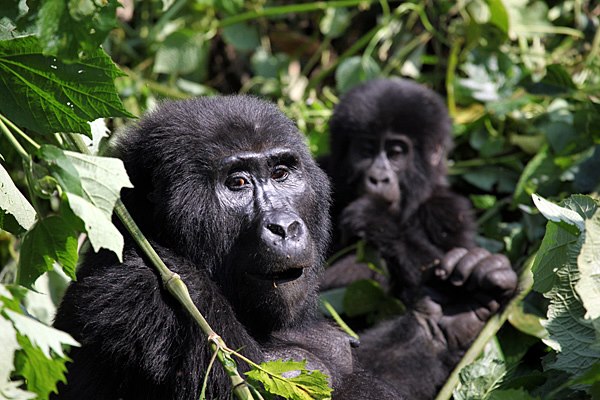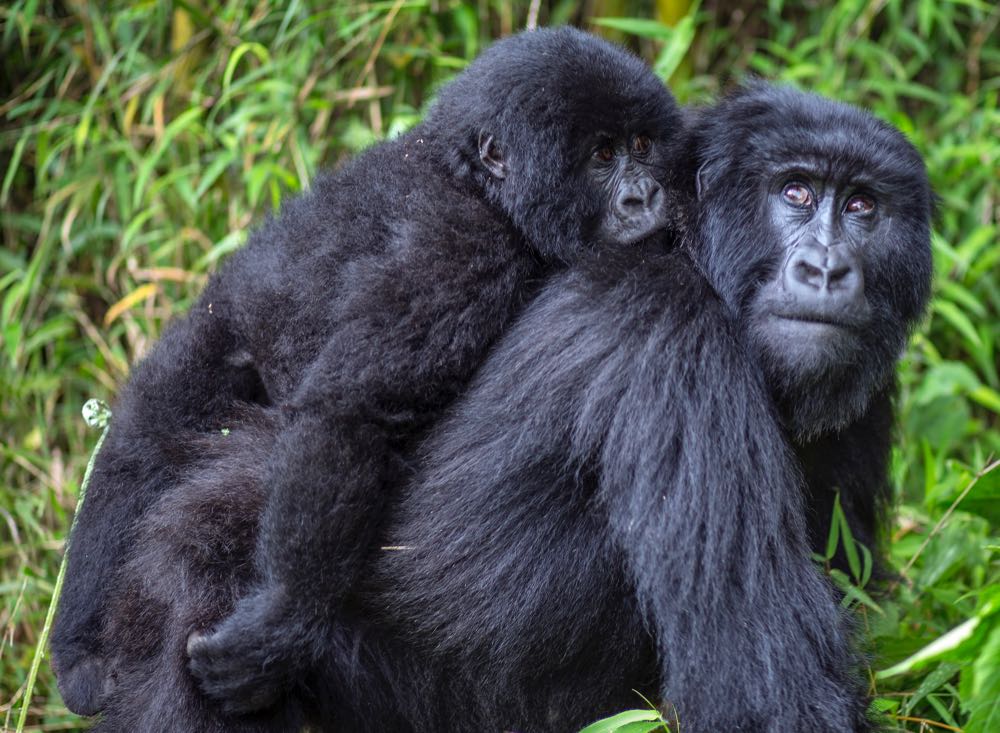Wildlife conservationists from Uganda, Rwanda, and the Democratic Republic of Congo (DRC) are over joyed by the results of a recently conducted gorilla census documented 604 mountain gorillas in the Virunga Mastiff.
The Virunga Mastiff is a 451 sq km area encompassing the Mikeno Sector of Virunga National Park in the DRC, Volcanoes National Park in Rwanda, and Mgahinga Gorilla National Park in Uganda. It is one of only two places in the world where the critically endangered mountain gorilla species are found.
The other place is Bwindi Impenetrable National Park in Uganda, where, according to published figures in 2011, 400 mountain gorillas live. The census, conducted from October to December 2015 and March to May 2016, did not extend to Bwindi Impenetrable National Park. However, when the results are combined – 400 mountain gorillas in Bwindi and 604 mountain gorillas in the Virunga Mastiff– as of June 2016, an estimated 1,004 gorillas exist in the wild.
The results were unveiled on May 31, 2018 by the Greater Virunga Transboundary Collaboration (GVTC) at Lake Kivu, Serena Hotel in Gisenyi, Rubavu, Rwanda, at an event attended by conservationists and scientists.
The increase in mountain gorillas is attributed to the effectiveness of conservation policies, regulated tourism, veterinary interventions, intensive law enforcement, community conservation projects and the transboundary collaboration among government institutions and non-governmental actors.
How survey was conducted
According to the results, 604 individual gorillas were found in 41 groups and as 14 solitary males. This is a sharp rise from a previous survey of the same area conducted in 2010 that showed an estimated 480 individual gorillas in 36 groups and as 14 solitary males.
Survey teams (consisting 80 people for each of the two phases of the census) walked predetermined reconnaissance trails ensuring a thorough sweep of the Mastiff. When fresh gorilla signs were detected, the teams followed the gorilla trail to locate three recent night nest sites. At each of these nest sites, the teams collected faecal samples from the nests, which were analysed genetically to determine individual genotypes.
The survey teams were protected by rangers from the respective authorities in the three countries – Uganda Wildlife Authority (UWA), I’Insititut Congolais pour la Conservation de la Nature (ICCN) and Rwanda Development Board (RDB).
Boost to conservation
The rise in numbers of mountain gorillas in the Greater Virunga Landscape (GVL) shows that conservation is the way to go if the region is to increase the benefits from tourism.
Sam Mwanda, the executive director of UWA, says Ugandans should be glad for the increase. “I have heard people say that the gorillas in Bwindi are migrating to Congo, but that is a myth. These wild animals have no idea where a boundary is. Besides, Sarambwe Nature Reserve in DRC which is opposite Bwindi is not conducive for the gorillas. So, Ugandans should not be worried.”
He adds that as long as the three countries are merging their conservation efforts, the exact location of the gorillas does not matter. “What is important is that they are protected wherever they are. For instance, the Nyakagezi gorilla family in Mgahinga visited Rwanda in early 2011, stayed away for a year and then, returned.”
The Nyakagezi family consists of three silverbacks, two adult females, two blackbacks, two juveniles and one infant. Also, a gorilla silverback migrated from DRC more than 10 years ago and founded the Kwitonda gorilla family in Rwanda, which has about 28 members.
The relationship between the three countries is such that when a group moves from one country to another, through GVTC, the former host country can do tourism in the adopted country and share the revenue.
Communities at the centre of conservation
It is important to recognise the role of the communities that live in close proximity to the national parks. They co-exist with the mountain gorillas, thus contributing to conservation efforts.
Eugene Mutangana, the head of conservation department in RDB, says, “Conservation efforts are nothing if they do not incorporate the input of the communities. Conservation should contribute to poverty reduction.”
A population explosion has led to a wildlife-human conflict, where farmers encroach on the protected area and the animals eat their crops and animals. To sustain their livelihood, sometimes members of the community kill the wild animals.
“The protection authorities in the three countries need to work with such communities to create awareness about the benefits of wildlife,” Mutangana advises, adding, “If they see the benefits, they have reason to protect this wildlife. In Rwanda, the population explosion is a challenge and there is no promising because family planning is not our priority.”
An increasing population living near the Greater Virunga landscape is a complication, especially when many people are still living below the poverty line. This has led to an increase in illegal activities in the national parks.

Poaching on the rise
According to the survey statistics in 2016, 246 snares were found in the Virunga Mastiff, as compared to 218 in 2010. In the last 20 years, more than 176 game rangers have been killed in the DRC.
Joel Wengamulay, the head of communications and external relations of Virunga National Park, says the loss of his colleagues is a sign that the rangers are ready to face the challenges of conservation.
“We are paying a high price. These rangers are not just figures to me; they are colleagues and friends. I was with some of them a few hours before they were killed. The many snares are a small problem compared to the insecurity in DRC. To improve the security situation, we are now having regular joint operations with the (DRC) army,” says Wengamulay.
For its part, Rwanda has undertaken a zero poaching strategy, is increasing patrol coverage in the national park, and is investing in training and equipping the rangers. The outdated law against poaching is also under review.
According to Mwandha, in Uganda, the wildlife populations are growing because the conservation efforts are in high gear. “Unfortunately, though, we cannot entirely put an end to poaching because it is a process that involves awareness, law enforcement, and improving the livelihoods of communities around the parks.”
Of course, an increase in law enforcement is a big boost for conservation because some of the poachers are not into the business because they cannot find something to eat; they are in it for the huge sums of money involved in dealing in the illegal trade of wildlife.
The oil resource should be managed
Since the discovery of oil in the western part of Uganda, conservationists have raised questions the effects of the drilling process to conservation. However, Mwandha urges them to take heart.
“In the 1990s, UWA was very much concerned when the exploration of oil began in the parks. But the government was determined to get the oil so we got an agreement to ensure that exploration is done in an environmental friendly manner.”
In the early 2000s oil drills took place in Murchison Falls National Park but the sites have since been restored. “Now that we are going into oil production, there will definitely be an impact on wildlife,” Mwandha says, adding, “However, I believe that we can engage the different government agencies to minimise those impacts.”
Since the three states are developing countries, there is need to balance conservation and development. Mutangana advises that conservationists should design business oriented models. “We should shift from the mentality of just conserving for pleasure to see the numbers grow. We need to conserve with an attitude that looks at solving the issues our countries are facing such as, unemployment and poverty.”
He adds that governments cannot ignore the resources under the landscape. Instead, they must develop tourism in a way that generates income to rival other sectors.
There is cause for worry, though, because it is believed that if oil exploration should be done in the DRC, 85 per cent of the Virunga Mastiff will disappear and the impact on the ecosystem will be irreversible.
Tourism with conservation
Uganda Gorilla trekking permits cost $600 (Shs2.2m). However, not everyone who wants a gorilla trekking permit in Rwanda will get it. Last year, the country came under some criticism for increasing the price of gorilla trekking permits from $750 (Shs2.8m) to $1,500 (Shs5.6m) for all visitors. Rwandan citizens, who previously paid $36 (Shs134,600) for a permit now, have to pay the new fee. One of the consequences of this decision is that local tourism has gone down.
However, Mutangana justifies this by saying there is a need for a change of mindset. “If you are a citizen, what do you need? You need money and that is what we are tapping. Do you want to spend money on visiting gorillas or on attracting more foreign tourists?”
He adds that there is need to control the influx of tourists to the country’s limited resources. “We are thinking high-end tourism. Our national park is only 160 sq kim so we have to think about sustainability, conserving for tomorrow’s generations. If we relax now, then tomorrow, we will not have what we have today. Unlike other countries, we do not have much to offer so we need to appropriately tap into the little we have.”
Ten per cent ($150/ Shs570,000) of the tourism revenue generated from each tourist goes towards funding development projects in the adjacent communities.
Much as the census results are a step in the right direction, mountain gorillas are still vulnerable to a limited habitat, climate change, disease, and human activity. Conservationists must join efforts to ensure that future generations benefit from this umbrella species of the Greater Virunga Landscape.
Contact us to arrange a cheap gorilla tracking safari in Uganda via info@travel256.com or call us on +256701367970.

